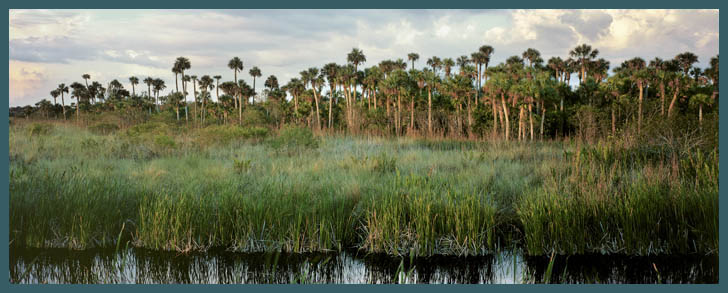|
Florida Everglades
Bats: Misunderstood for Centuries
For centuries bats have been portrayed as evil and menacing when in actuality they are quite harmless and highly beneficial mammals. Many myths and misconceptions still abound. Bats are not dirty blood suckers - they actually groom themselves quite frequently, much like cats. Bats are not rodents or flying mice. Bats are not blind, nor are they aggressive or "carry" rabies. (They are capable of catching this disease much like other mammals.) Bats are among the most gentle of creatures here on earth. They are very shy but highly intelligent mammals. Bats are wild animals and should be treated and respected as such. Even though the life expectancy of a single bat can exceed 20 years, their slow birth rates are limiting their population growth. Did you know that when a mere five bats are killed needlessly, a potential 100 years of animal life is destroyed?
Bats have the same five senses that humans do: feeling, seeing, tasting, smelling and hearing. And speaking of hearing, bats have highly developed sonar capabilities called echolocation that help them locate their prey in the darkest of nights. (Whales and dolphins also have this same capability.) The bat emits a high frequency sound, usually through its mouth - and much too high for human ears to hear - and the sound travels until it hits an object. The sound waves then bounce back to the bat's ears and using this as a reference point, the bat can now obtain a mental picture of his surroundings and scoop up his prey.
Bats inhabit nearly all areas of the globe, excluding the extreme desert regions and Antarctica, but most species can be found living in the tropics. Scientists have grouped the 1,000-species of bats in their own order, called Chiroptera. This Latin word meaning "hand-wing" describes their very existence since the wing of a bat is very similar to a human hand; however, the bat's fingers are elongated. Bats are the only mammal that can truly fly. Sadly with their ever-declining numbers, we know very little about them because man has spent more time and energy attempting to remove them than trying to understand them.
These nocturnal mammals secure shelter in a variety of places that include mines, caves, under tree bark, buildings and rock crevices. Several bat species in Florida roost in caves and the caves that breeding females give birth to are known as maternity caves. Bats roost on the ceiling of the cave, close together for both protection and warmth. Bats are among the slowest reproducing animals on earth, normally giving birth to one "pup" each year.
Historically speaking, bats have been around for a really long time. Bat fossils have actually been found, complete with insects in their stomachs, dating back millions of years ago. "As mammals they came from a long lineage of animals that arose from the Therapsid reptiles in the Triassic, some 120 million years ago," according to Brian Carstens, an Organization for Bat Conservation volunteer.
Bats are extremely beneficial. It has been reported that 70 percent of all bats in the world eat insects. Did you know that one little brown bat can eat anywhere from 600 to 1000 mosquito-sized insects every hour? Or, did you know that most insect-eating bats eat their body weight in insects each evening? Fruit bats in our tropical rain forests pollinate and disperse seeds in excess of 80 percent; which is extremely incredible given the rate of destruction in these regions on a daily basis. Without these bats, we might never see the regeneration of our tropical rain forests. Bats in North America play an extremely important role in our environment - the more bats there are in any given area - the lower the amount of pesticides are used in that same area. Farmers have long appreciated their presence as well as assistance in consuming crop pests thereby saving them millions of dollars. In addition to insects they also eat fruit, fish and small vertebrates and nectar too. On the medical front, doctors have used the advance sonar system found in bats to work with the blind; and even the highly disgusting vampire bats, found in Central and South America are also being used in heart patient studies.
Types of Bats Found in Florida
Bats come in many different shapes, colors and sizes. In Florida, there are 13 species of bats, all insect-eaters that either reside year-round or seasonally. These bats are quite small weighing about an ounce and measuring a 6-to-10-inch wingspan. The 13 species include the Big Brown Bat that clearly ranks among America's most beneficial mammals, due to its eating habits. It can be found in a wide range of habitats of the northern two-thirds of Florida. Eastern Pipistrelle bats, found throughout most of the state, are Florida's smallest bat and often mistaken as large moths. Adults weigh about 1/5 of an ounce. This yellowish to yellowish-brown bat is among the first bats to emerge at dusk each night. Evening Bat is a Florida native species, closely resembling the big brown bat, but smaller in size. Its fur is usually a dark brown but may also have a bronze to reddish tint. They are one of the few bats inhabiting the Everglades; and most often found near stands of cypress. Gray Myotis is listed as Endangered since 1976 after an 80% decline in less than two decades. Approximately 95% of the entire known Gray Myotis population hibernates in just nine caves each winter. Seminole Bat looks much like the Eastern Red Bat, except that the Seminole's coloring is almost a mahogany shade. The Seminole is a common solitary roosting bat normally found in lowland, forested areas. These bats also emerge quickly to forage. Velvety Free-Tailed Bat is also known as the Pallas's Mastiff Bat. These bats emerge early in the evening to begin foraging for their insects. Brazilian Free-Tailed Bat is one of the most abundant bats in Florida. They are rather small and dark-to-light brown in color with a wingspan of 290-325 millimeters enabling them to fly faster than all other bats with their long, narrow wings. They are also called the Mexican Free-Tailed Bat. They are named free-tails because the lower half of their tail is free of the membrane. Eastern Red Bat is bright red in color and one of North America's most abundant tree bats. They are more solitary, coming together only to mate and migrate. Their long silky fur provides them with extra protection from the extreme cold and they wrap themselves in their furry tail for additional warmth. The Florida Bonneted Bat species is quite rare and listed as Endangered by the Florida Fish & Wildlife Conservation Commission. It has been found in the Babcock/Webb Wildlife Management Area in nearby Charlotte County as well as our own Fakahatchee Strand Preserve in East Naples and in both Homestead and Coral Gables in Miami-Dade County. This species has rarely been observed during the past four decades. Hoary Bat is one of America's most handsome and largest bats. Their most common prey is moths; but they also enjoy beetles, flies, burrower bugs, crickets, and stink bugs. The Hawaiian Hoary Bat feeds heavily on damp wood termites. Snakes and birds rank as the most important predators of these bats. Northern Yellow Bat is one of Florida's larger bats with long wings. It has yellowish orange or brown-to-nearly gray fur. These bats have relatively short rounded ears and they live in a variety of coastal habitats that contain either palm trees or Spanish moss while feeding on flies, flying ants, mosquitoes and leafhoppers. Rafinesque's Big-Eared Bat is one of the rarest bats in Florida with rather large ears that measure more than an inch in length. It also has two large lumps on its snout giving rise to another common name for this species, the lump-nosed bat. Southeastern Myotis is one of the two most abundant species in Florida living in the northern half of the state.
Don't forget the extremely rare Wagner's Mastiff Bat, one of the two free-tailed bats in Florida. Believe it or not, its four-to-six inches in length and weight of between one half and two ounces places the Wagner's Mastiff Bat as one of the largest of Florida's bats. These bats also have a loud, piercing call that even humans can hear. In past decades this bat had been seen in the Miami area but was only spotted twice since 1967 - and one of these sightings involved the capture of a pregnant female in 1988 in Coral Gables, who quickly escaped and is still on the lam! It has been added to the Threatened listing.
Protection
Bats are disappearing at alarming rates. Sadly, half the bats in the United States are listed as rare, threatened or endangered. Destruction or disturbance of roost sites caused by both vandalism and development is the greatest threat to the world's bats. Fear and misunderstanding are the worst enemies of bats. Bats living here in Florida prefer to roost in either mature or dead trees or also in caves. Because bats are not in abundance to begin with here in south Florida any decline of numbers is cause for concern.
Individually and collectively, bats can be adopted or sponsored through several Adopt-A-Bat or Sponsor-A-Bat programs listed in the various bat protection agencies' websites, given below. Literally hundreds of bats become either injured or orphaned each year and there are few agencies available to provide both care and financial support. Your donations help to buy medical supplies, food and to maintain the few sanctuaries offering these mammals a second chance. Check out their websites for additional information.
When first class postage was a mere 37-cents, bats went postal…that is, their likeness was added to the postal stamps and provided wonderful and much-needed promotion for the plight of the bat.
The mission of the Florida Bat Conservancy located in Bay Pines, Florida is to preserve and protect native bat populations within the state of Florida. For additional information or to join in their efforts to protect bats check out their website at www.floridabats.org and be sure to sign up for their informative "Night Flyer Newsletter" with its numerous success stories on bats. Spreading the word about the bats' benefits to humans is the goal of the Florida Bat Conservancy.
There are 15 Bat World regional rescue centers in the United States and the closest one to us in Southwest Florida is at Bat World Everglades Sanctuary in nearby Fort Ogden (DeSoto County) where bats are provided a safe sanctuary and used for both educational and outreach programs, in addition to its rescue mission. www.batworld.org. Still not convinced? Take a tour, by reservation only, and offered weekdays during April, May, October and November. Tours for a maximum 45 people; are offered as either educational school field trips or group tours, such as gardening or nature groups. Check it out on their website.
The ABCs of the Florida Landscape is written by freelance writer Maureen Sullivan-Hartung who has resided in Naples for nearly 30 years and loves learning about all aspects of the local flora and fauna. Another passion of hers is history and she authored a book in November 2010, titled, Hidden History of Everglades City and Points Nearby, published by The History Press. Check her website for the book's availability or additional information about the author at: www.maureenwrites.com
msh22011
For more information on Bats, check out these books:
America's Neighborhood Bats by Merlin Tuttle
Bats by M. Brock Fenton
Bats of America by Roger Barbour & Wayne Davis
Bats of Florida by Cynthia & George Marks
Florida's Fabulous Mammals by Dr. Jerry Lee Gingerich
Stokes Beginner's Guide to Bats by Kim Williams, Rob Mies, Donald & Lillian
Understanding Bats by Kim Williams and Rob Mies
Walker's Bats of the World by Ronald Nowak
Bat Websites:
www.batworld.org
www.batplants.co.uk
www.batconservation.org
www.batcon.org
www.batroost.com
Magazine:
Bats Magazine, published quarterly
|


